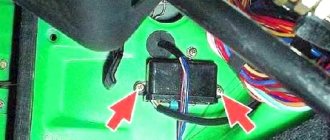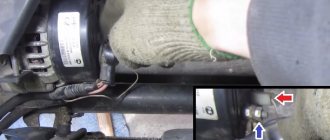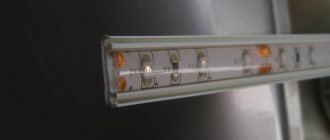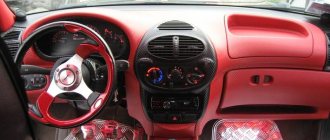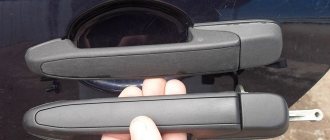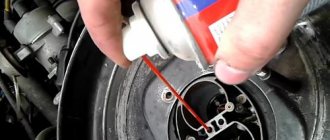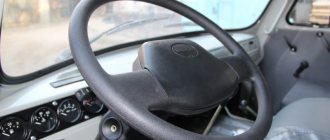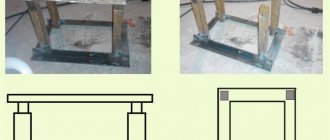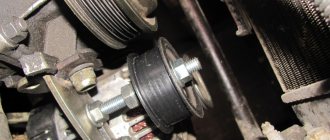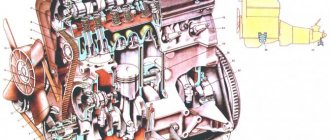How to easily and quickly remove the dashboard on a VAZ 2110 with your own hands?
Without a doubt, the dashboard is the most noticeable interior detail in a car, because it is located right in front of the eyes of passengers and drivers.
The need to remove the dashboard on a VAZ 2110 may arise for car owners for a variety of reasons. So, by removing this part, you can get full access to all the electrical components of your vehicle, replace the burnt-out wiring with a new one, connect additional devices or lighting, install a Euro trim or sound insulation.
Options for replacing the standard VAZ 2110 panel:
If desired, you can cover the dashboard with various materials of your choice, thereby making the desired changes to the interior of the cabin.
I would like to say right away that removing and replacing a torpedo on a VAZ 2110 will require a lot of time and patience from you. In addition, all repair work must be carried out extremely carefully and carefully so as not to accidentally break the fastening, since the dashboard will not fit back as it should and will creak when driving.
To work you will need the following tools:
- marker;
- self-adhesive labels;
- set of screwdrivers and wrenches.
We remove the VAZ 2110 torpedo and install the trim: detailed instructions with photos
In the interior of the VAZ 2110, the dashboard is the most noticeable part. Every driver wants to sit in a stylish and well-maintained interior. But the standard panel looks angular and gray. This is especially noticeable after long-term use, when abrasions, scratches and cracks appear on the panel. Motorists solve this problem in different ways - some install another standard dashboard from a VAZ 2110, other drivers prefer to install a Europanel - this is the name of the trim from a third-party manufacturer. The trim allows you to transform the interior and turn the “ten” into a foreign car, at least on the inside. Whatever you choose, removing the panel is a must. In this material we will tell you how to properly dismantle the standard panel and install the Euro version.
Alternative torpedo
The alternative dashboard is softer than the standard “tens” dashboard, but the main advantage is the absence of unpleasant grinding and squeaking. Motorists decide to get rid of the standard one precisely because of the squeaking. For the VAZ 2110 car there are several types of panels that differ in design.
The panel is sold as a set:
- The panel itself, which is an alternative to standard plastic.
- Buttons, brackets and inserts for blowers and instrument panels.
- A set of wires and a block for a double switch.
- Buttons for low beam, heating, dimensions and fog lights.
- Plugs for buttons are installed in places where keys are not needed.
The experience of the owners of the “Ten” shows that proper removal and installation of the Europanel improves sound insulation, increases airflow and changes the appearance of the VAZ 2110 interior for the better.
We remove the torpedo
Removing and installing a new torpedo on a VAZ 2110 takes a lot of time, we also advise you to be patient, since there are dozens of connections and wires in this part of the interior. Each action must be careful, since the VAZ 2110 mounts are very fragile and can be easily broken. After this, the panel will no longer fit properly, and the car will noticeably increase in squeaking while driving.
In some cases, it is not necessary to completely dismantle the standard panel. Our article provides a description of a complete analysis.
Necessary tool
To remove the case, you should have in your arsenal:
- Labels with adhesive backing.
- Marker or pencil.
- Set of screwdrivers and keys.
The main assistants in this work will be a 10 mm wrench and a Phillips screwdriver. We need a pencil or a washable marker in order to mark the removed elements. This also applies to self-adhesive labels. There are too many wires and parts, after disassembling you will already forget where each component is located. Markings and stickers will remind you of the location of wires and parts.
Preparatory work
Some people prefer to disassemble without dismantling other components of the interior, but this significantly complicates and prolongs the work. We recommend preparing the interior as you will need room to maneuver. Remove the seats and steering wheel - follow this sequence. It is also worth dismantling the floor tunnel.
To do this, you need to unscrew the screws and move the VAZ 2110 part back. We perform the same operation with the lower part. The next step is to dismantle the glove compartment, now you can remove the mounting block and relay. During the process, each wire must be labeled. You need to be especially careful when handling speedometers.
Removal - step by step instructions
- We find the central panel, on the right side of it there are two self-tapping screws - unscrew them. We do the same with the opposite side. Now we dismantle the shield on both sides, as shown in the photo.
That's it, the torpedo is dismantled, you can replace its individual components, install another panel from a VAZ 2110, or carry out tuning using a Europanel. Assembly proceeds in reverse order. Will there be an overlay installed instead of the standard panel? Then move on to the next section.
Installing the dashboard trim
The cover will be installed after complete disassembly - it’s easier and more convenient. The instructions say that the trim must be cut around the perimeter. Now you can assemble the case: we place in it the accessories and instrument connectors that came in the kit. Carefully lay out the wiring from the base of the cover. All joints of the new VAZ 2110 panel must be glued with anti-creak.
We attach additional harnesses to the standard wires and tighten them with zip ties. Please note that there are additional buttons on the cover - standard connectors must be connected to them. The cover is attached to the original panel using self-tapping screws. Now you can carry out the installation in reverse order.
Conclusion
The main advantage of the installation after complete disassembly is that we can carry out high-quality sound insulation behind the plastic, because it is from there that the strong noise of the power plant comes from. Don't skimp on the anti-squeak. The work will take a lot of time, but it's worth it.
Removal instructions
It is recommended to remove the VAZ 2110 torpedo in the following sequence:
- Interior details. Before starting work directly, it is necessary to prepare the interior, since disassembling the front panel of the VAZ 2110 is best done with room for maneuvers. Therefore, the first thing we do is remove the front seats and steering wheel of the car. It is advisable to carry out dismantling in exactly the same sequence as indicated above, since otherwise it will be extremely difficult to remove the driver’s seat. In order not to break anything, consider your strength when pulling the wheel out of the column splines; to do this, loosen the steering wheel nut a little, and then pull it towards you while loosening it from side to side;
- Transmission tunnel. After the salon is prepared and there is a place to work, we are faced with the next task - dismantling the floor tunnel in the salon. Simply unscrew the screws and push the top of the part being disassembled back. Then do the same with the bottom of the tunnel;
- Steering wheel and steering column. Unscrew the screws on the steering column casing of the VAZ 2110, and then remove the steering column switches. Mark all the wires and connectors released during disassembly with a marker or labels; this will later work to your advantage when, when assembling the torpedo, you end up with a large number of wires of different colors. It is recommended to use the marking especially for owners of cars that are already equipped with an audio system and alarm system;
- Glovebox. The next stage of work will be to dismantle the glove compartment, after which it is necessary to remove the relay and mounting block. Don’t forget to mark the wires as you work and take special care with the fragile speedometer and other dashboard elements that also require special treatment;
- Torpedo. And now we can move on to the immediate purpose of the repair - we have to remove the dashboard. To do this, it is necessary to unscrew the screws in the resulting void behind the glove compartment and unscrew the fastenings. After that, use a screwdriver to hook the air duct on the left side and remove it. Then all that remains is to unscrew the nut, holding the torpedo with your hand, the torpedo and pull it out from the studs, at the same time do not forget to mark the wires with a marker so as not to get confused.
The dashboard has been removed, we have disassembled everything that needed to be disassembled, all that remains is to carry out the repair work, for which the whole procedure was actually started.
Finally, I would like to advise - take the opportunity, do not be lazy and clean the ventilation ducts, sooner or later they will still become clogged and you will have to remove the dashboard again.
When disassembly is required
There are several reasons why car owners want to remove the tidy:
- It is damaged by mechanical shocks, as a result of hitting potholes, etc. In fact, the strength of the standard dashboard leaves much to be desired, so damage is not uncommon for dozens;
- There are scratches and abrasions on the surface of the device, the paint has peeled off somewhere, and there are signs of wear. That is, the appearance of the panel leaves much to be desired, so to correct the situation it needs to be removed;
- The desire to transform the interior of the car. Many VAZ 2110 owners decide to get rid of the old dashboard in order to put something more modern, original in its place, and change the backlight to LED lights.
If you connect something incorrectly and reassemble the panel without checking, you risk not only having to re-disassemble the dashboard, but also encountering non-functioning devices, short circuits and even worse consequences.
Now let's talk specifically about how to remove the panel on a VAZ 2110. To do this, it is enough to follow a certain sequence that will allow you to dismantle the unit correctly and quickly without unnecessary risks.
Removing the lining
Many motorists, being confident in their own abilities, ignore recommendations and do not follow instructions. At the same time, they remove the panel, while simultaneously dismantling another half of the interior.
The step-by-step guide we offer will allow you to avoid unnecessary manipulations, save time, effort and nerves.
- Buy special self-adhesive pieces of paper. The type that they stick on products in stores. You will also need a marker, pen or just a pencil. Each element to be removed should be marked so as not to get confused later when reassembling the elements. Write down the sequence on a piece of paper, or have your assistant do it under your dictation.
- Removing the front seats will make access to the instrument panel much easier. You won’t have much time to sit on them, and in order to get to certain fastening elements, the chairs may simply get in the way.
- There are screws on the sides that will allow you to remove the tunnel. Moreover, the upper part is removed first, and only then the lower. The order is not important, you can try in reverse order. Only then will it be frankly inconvenient for you to work. Tested by many craftsmen when disassembling the dashboard.
- Remove the steering column cover. This way you can remove the cover itself, as well as the steering wheel. To perform this task, three self-tapping screws and four fixing screws are removed. The steering wheel will sit on the splines quite firmly, so you will have to remove it with force. You can shake the steering wheel to the sides, tug. Just take care of your face, because with a sudden force the steering wheel can fly out of its seat and fly right at you.
- The steering column switches must be removed.
- Remove the glove compartment fasteners and remove it from its seat.
- After that, proceed to the mounting block. You have to remove not only the cover, but also remove all the connectors and relays.
- Now it’s time to figure out how to remove the VAZ 2110 panel trim and pillar trims. This is done quite simply, given that all fasteners are not hidden. Be sure to unscrew the fasteners of the headlight hydraulic corrector and push it inward.
- Now comes one of the most important moments - removing the screws that hold the instrument panel. They connect the panel to the body of your car. Unscrew the screws and two studs. It is not difficult to find them, since these studs are located under the cover of the air supply tunnel to the side windows.
- Having completed all the specified procedures, only the lower air duct and the steering shaft will hold the panel. After this, you can begin the planned repair or modernization of the car, which required the mandatory removal of the dashboard.
How to remove a torpedo on a VAZ 2110 with your own hands
VAZ 2110 owners pay attention not only to timely maintenance and vehicle serviceability. Appearance, interior trim, and instrument panel play an important role. Sometimes it becomes necessary to disassemble the front inner lining of the car. The article will help car enthusiasts independently remove, replace individual elements, change the interior, torpedoes of a VAZ 2110 car, and perform the necessary repair and maintenance work.
Types of torpedoes on the VAZ 2110
The VAZ automobile plant produces a number of different modifications of the VAZ 2110. The differences concern not only the power unit, transmission, systems, and mechanisms. The surroundings of the cars are undergoing changes. The main options for completing the front panels are known.
Basic old sample. Simple strict design. The instruments are located opposite the steering wheel.
Export solutions Euro-1, Euro-2, Euro-3. Management and control bodies have been changed.
Overlay panels "Chestnut":
- with a standard layout (reminiscent of the first issue);
- The dashboard is in the center, to the right of the steering wheel.
Home craftsmen contribute to the decoration and replace the cladding using spare parts from other car models. The landing mounts of the released panels and torpedoes match. It remains to pay close attention to the wiring and establish the correspondence of the signals.
Preparing to remove the torpedo on a VAZ 2110
To work you will need:
- standard set of wrenches (open-end, socket, ratchet wrench with a set of heads),
- flat blade screwdriver, Phillips head,
- mount,
- marking tags (sign connectors),
- attentiveness, patience (there is delicate, painstaking work ahead).
It is necessary to remove the driver's, passenger's seats, and steering wheel.
Procedure for removing the torpedo
If you decide to start replacing the torpedo on a VAZ 2110, then follow these steps:
- Unhook the torsion bars from the front under the seat (take them out of the fixing brackets, pry them up with a pry bar);
- unscrew the four nuts;
- remove two fasteners, release the front stop;
- from the rear seat side, using a 10mm ratchet wrench, unscrew the three bolts securing the seat to the runners;
- push back, tilt the seat back;
- unscrew the 2 front bolts securing the guide skids;
- remove the seat from the car, do the same with the second seat;
- pick up and remove the silver “Lada” plate on the steering wheel;
- unscrew two self-tapping screws;
- remove the top cover;
- lock the steering wheel;
- Using a 24 mm socket wrench, unscrew the nut in the center of the column;
- Lightly tapping the wheel from bottom to top with the heel of your palm, swaying left and right, remove the steering wheel from the splines. The salon is ready.
Step-by-step instructions for removing the VAZ 2110 dashboard
If you decide to start working on removing the torpedo with your own hands, then first read the step-by-step photo guide; if you have any questions, below there is a description of the steps in text.
- Work that involves tampering with the vehicle's electrical wiring (disconnecting connectors, devices) begins with disconnecting the negative terminal of the battery.
- Remove the steering column trim, disconnect the steering switch plug, remove the switch, ignition switch, block with wires.
- Disassemble the floor tunnel:
- On the left and right of the tunnel, facing panels with slots are secured with four self-tapping screws (through them warm air is supplied to the feet of the driver and front passenger). Use a Phillips screwdriver to remove the cladding elements.
- There is a rectangular plastic plug between the handbrake and gearshift levers. Using a flat blade screwdriver, carefully pry and remove the tunnel cover part.
- Remove four self-tapping screws securing the tunnel lining, in pairs, two on the right, 2 on the left.
- Lift the facing box from the rear edge and move it back a little.
- Disconnect the cigarette lighter and window controls (if the car is equipped with an electric window system) from the on-board power supply (plastic connectors), and mark them.
- Turn the cover to one side and, from the inside, disconnect the fastener holding the gearshift lever housing. Place the lid aside.
- Using a wrench, unscrew the nut securing the metal air duct to the floor on the passenger side. Remove the heat pipe.
- The base of the tunnel is held in place by four nuts: two in the middle, the rest in the rear. A 10mm socket wrench will help remove the fastening. Remove the box from the car.
- Remove the glove box.
- Unscrew the self-threaded fasteners on the hinge brackets with a screwdriver.
- Disconnect the backlight wires, hold the structure from below, and remove the box.
- Remove the mounting block.
- Press the latch button and easily fold the fuse box down.
- Unscrew the self-tapping screw and remove the latch.
- Lift, turn the block over, disconnect the wires, take it out. Don't forget about labeling.
- Detach the compartment door.
- Removing the torpedo.
- In the depths of the opened niches, screws are visible that secure the instrument panel. Remove them with a screwdriver with a cross on the end. Do the same with the lower side screws.
- The instrument panel is screwed to the controller bracket with two screws. While holding the head from turning with a screwdriver, unscrew the nuts with an 8-mm open-end wrench.
- Pry and remove the grilles of the side air exchange nozzles in the cabin.
- Two nuts secure the panel at the top. Using a ratchet wrench and a 10mm socket, remove the fasteners.
- Using both hands, remove the structure from the studs and bring it into the salon.
- Arm yourself with marking material, sequentially disconnect and mark the pads.
- Unhook the headlight hydraulic adjustment.
- Remove the dashboard.
- Use a tool to separate the air duct from the air distributor.
- Carry out the necessary work. Assembly occurs in reverse order. Plastic latches require careful handling. Tighten the screws gently. Lubricate threaded connections.
If you still have questions about removing the torpedo on a VAZ 2110, I recommend watching this video:
How to remove the dashboard from a VAZ 2110 (VAZ 2111 and VAZ 2112)
Added Mar 31, 2015 to Dashboards
Removing the dashboard (dashboard) may be necessary to replace parts that have become unusable or to solve various tuning problems. Of course, most often the instrument panel is removed precisely for its tuning. For example, this could be covering the panel with leather or replacing the instrument cluster with a more attractive and advanced option. You can read about tuning the dashboard of VAZ 2110 cars here.
We will talk about removing the dashboard in this article. In particular, we will consider in detail the dismantling process itself, as well as all the nuances that should be taken into account when performing this work. So, let's begin.
Removing the instrument cluster from a VAZ 2110
First of all, let's consider dismantling the instrument panel from cars of the tenth family. The process looks like this:
1. Disconnect the negative terminal from the battery. We set the wheels in a straight position and put the car on the parking brake.
2. Lower the steering column to the bottom position. Using a screwdriver, unscrew the upper screws securing the decorative trim of the instrument panel. We also unscrew the lower fastening screws in the same way.
3. With some effort, pull out the decorative trim and move it onto the dashboard. If the length of the electrical wires is not enough for this, disconnect the connectors with wires from the switches.
4. Unscrew the screws securing the instrument cluster itself. After this, use thin-nose pliers or small pliers to straighten the petals that secure the instrument cluster.
5. Pull the instrument cluster out of its seat, disconnect the connector pads and remove it completely.
Reinstalling the instrument cluster in its original place is carried out in the reverse order.
Now that we've sorted out the removal of the instrument cluster, we can move on to considering the process of dismantling the dashboard.
Removing the instrument panel on a VAZ 2110
1. As in the case of removing the instrument panel, first of all we disconnect the negative terminal from the battery.
2. Unscrew the two screws of the horn button, then pry up the decorative trim with a flat screwdriver and remove it.
3. Using a Phillips screwdriver, unscrew the screws securing the lower steering column casing and remove it. After this, lower the steering column to the lower position and remove the upper casing, for which we unscrew the corresponding mounting screws.
4. Using a socket wrench or a wrench and a socket, unscrew the steering wheel mounting nut. An important point: we do not unscrew the nut completely, that is, in such a way that it remains on the steering column shaft for about two or three turns of thread.
5. Using fairly sharp blows, knock the steering wheel off the shaft splines. Next, completely unscrew the steering wheel nut and completely remove it from the shaft.
6. Loosen the mounting bolt of the base of the steering column switches. After this, move the base of the switches towards you.
7. Disconnect the electrical wire from the oil level sensor. We also disconnect the audio signal wire connectors. Completely remove the base of the steering column switches.
8. Insert the key into the ignition switch and turn it to position “I”, thereby unlocking the steering column shaft. Disconnect the ignition switch wiring harness.
9. Unscrew the screws of the decorative cladding on the right side of the central tunnel and remove it. Similarly, we remove the lining on the left side.
10. Use a flat screwdriver to pry off the decorative plug on the central tunnel. After this, unscrew the screws on both sides of the tunnel.
11. Use a Phillips screwdriver to unscrew the screws that secure the central tunnel in its rear part. Raise the central tunnel a little.
12.Remove the interior heating air duct. Disconnect the cigarette lighter connectors and remove the gear shift knob cover. We completely remove the central tunnel.
13. Unscrew the screws securing the glove compartment. Pulling it slightly towards you, disconnect the backlight wires from it and completely remove the glove compartment.
14. Unscrew the fastening screws, which are located inside the storage compartment (behind the glove compartment).
15. Unscrew the screws securing the dashboard to the front of the car body. First unscrew the right screw, and then the left fastening screw.
16. Using a “10” key and a Phillips screwdriver, unscrew the bolt securing the central part of the instrument panel.
17. Using a straight screwdriver, remove the air duct grille. Unscrew the nut securing the dashboard to the body. We do the same with the air duct on the left side of the panel.
18. Carefully pull the dashboard towards you and remove it from the mounting bolt studs. We disconnect all connector blocks with wires. At the same time, in order to ensure that everything is connected correctly when installed in its original place, we mark all connectors.
19. Completely remove the dashboard from the car. Installation is carried out in reverse order.
Removing and replacing the dashboard (front panel) on a VAZ 2110, 2111, 2112
Next, using a screwdriver, pry up and remove the plugs at the upper corners of the instrument panel mounting. In reality it looks like this.
On the other side, we do the same, after which, using a socket and an extension, we unscrew the nuts securing the instrument panel in the upper part.
Now let's move on to the remaining attachment points. At the bottom, in the left and right parts of the panel - in the corners, there is also one screw that needs to be unscrewed. The first one is shown below.
Of course, the mounting block will also have to be removed so that it remains intact with the sub-panel wiring.
Many owners who have owned a VAZ 2110 for a long time would like to change the boring panel to a more modern one. In this case, you can install a new type of panel from cars manufactured after 2006. or from the “Bogdan” versions, which are analogues of the tenth family, except perhaps of the Ukrainian assembly.
With such alterations, basically you won’t have to change anything, but it’s worth considering that in this case you need to buy a complete Europanel:
- instrument panel frame assembly with trim
- instrument panel (combination)
- buttons and switches
- heater deflectors
- New heater control unit
- sub-panel wiring
- steering wheel, cover and switches
Only in this case everything becomes without any problems with minimal labor costs.
There is another method of modifying and tuning the instrument panel, which consists of replacing the dashboard from the Priora - VAZ 2170. Of course, the appearance will be much more interesting than even the Europanel, but connection and installation require a lot of investments, both financial and physical. The main problem with this modification is that the connectors for the under-panel wiring of the Priora and the under-hood of the VAZ 2110, which of course need to be connected, are different, and the connectors simply do not fit together.
In this case, there are two ways:
- Completely take all the wiring from the Priora, including the engine compartment harness, interior harness, power window control unit, comfort unit, etc.
- Join completely two different types of wiring manually, cutting off the connectors and insulating almost every wire.
VAZ 2110 panel, removal, installation of dashboard, sound insulation of VAZ 2110 panel
The VAZ 2110 panel or the “tens” dashboard has become a new word in the interior design of Lada cars. Despite its interesting shape and ergonomic appearance, panel 2110 eventually begins to make a lot of unnecessary sounds when the car is moving. This is especially noticeable on cars with high mileage. Therefore, very often the “tens” torpedo is completely disassembled in order to carry out total sound insulation and eliminate squeaks.
Let's say right away that disassembling the VAZ 2110 panel is not difficult in principle, but it is a very labor-intensive job that requires time and attention. The fact is that to remove the panel you will have to completely unscrew the steering wheel and disconnect a lot of electrical connectors. In order not to damage the electrics, before disassembling the VAZ 2110 dashboard, be sure to disconnect the battery . This is how the “tens” panel looks schematically.
This figure shows in detail, in the smallest detail, all the fasteners of the VAZ 2110 panel.
- 1 – panel
- 2 – side nozzle for ventilation and heating of the cabin
- 3 – instrument panel trim
- 4 – cover fastening screws
- 5 – panel fastening screws
- 6 – box
- 7 – console trim
- 8 – cover
- 9 – instrument panel panel
- 10 – mounting block cover
If you remove the panel completely, then only this should remain, look at the photo -
The red arrows indicate where the nuts and screws are attached, and the two large white arrows indicate the special mounting pins. When installing the panel, it must be installed on them; they serve to center the dashboard relative to the body.
Removal and installation of VAZ 2110 panel
Below are step-by-step instructions for removing the “tens” dashboard.
- Disconnecting the battery
- Remove the steering wheel and steering column switches
- Be sure to remove the top lining of the floor tunnel
- Remove the glove compartment and unscrew the mounting screws
- Remove the headlight hydraulic adjustment handle by pulling it towards you
- Unscrew the hydraulic corrector nut and remove it
- Remove the upper side air duct deflectors by prying them up with a screwdriver
- Under the deflectors we find the panel fastening nuts, unscrew them
- We unscrew the screws from the bottom of the dashboard, next to the hood release lever, at the mounting block, in the niche of the glove box, etc.
- Now you can remove the door seals, remove the lining covering the front pillars
- Disconnect the electrical wiring terminals
- You can remove the panel by holding the steering column adjustment lever in the desired position
The fully unscrewed VAZ 2110 panel is supported by two guide pins (see photo above) with white arrows pointing to them. We assemble the panel in the reverse order.
Soundproofing panel VAZ 2110
To soundproof the “tens” dashboard, they mainly use bitoplast, modelin, sealant and even polyurethane foam. Bitoplast and modelin are used to cover plastic panels on a disassembled dashboard, which eliminates squeaks and improves sound insulation. Something like this in the photo below -
Bitoplast is glued with a special glue; when installed in place in the right places, this material is compressed where necessary. It is recommended to paste over the panel naturally from the inside.
Some craftsmen turn the front panel into an impregnable fortress for vibrations and squeaks using ordinary mounting foam. However, it is not recommended to use such a radical method without some experience. As a result, this is what sticks out from under the torpedo -
In addition to soundproofing the VAZ 2110 panel, it is necessary to carry out a similar procedure with the floor, roof, and doors. Such comprehensive sound insulation will ensure maximum acoustic comfort in the cabin.
In conclusion, I would like to say that there are two panels installed on the “ten”, old and new models. Photos of the old version can be found at the beginning of our article. A photo of the new version of the panel is attached below.
The most interesting thing is that a new-style panel or a Europanel for the “ten” can be installed instead of the old-style panel. In principle, they are interchangeable, but it is worth considering that along with the installation of a new panel, you will have to install a new instrument panel assembly, another ACS unit (automatic control system for interior heating) and add an electric heater damper drive. The mounting points of the old and new panels themselves are the same, so there are no problems with installation.
- VAZ 2110 stove, heater, fan, dampers, video of replacing the VAZ 2110 stove radiator
- Lada 110 or VAZ 2110 video, photo, technical characteristics of the VAZ 2110, “tens” engines
- VAZ 2110 engine, photo, device, characteristics of the VAZ 2110 engine injector, carburetor
Repair manual for VAZ 2110, 2112, 2111 (Lada 110)
You will need: regular and socket wrenches (head) “10”, a screwdriver with a Phillips blade.
1. Disconnect the wire from the “–” terminal of the battery.
4. Open the glove box, unscrew the two fastening screws from the bottom and remove it, disconnecting the wires from the contacts of the glove box light.
5. Remove the mounting block and its cover (see “Removing and installing the mounting block”).
6. Remove the hydraulic corrector switch handle by pulling it towards you.
7. Using a socket, unscrew the nut securing the switch and remove the switch from the back of the panel, leaving it hanging on the hoses.
8. Using a screwdriver to press down the plastic latch, turn the upper side nozzle and remove it. Similarly, remove the nozzle from the opposite side of the instrument panel.
9. Remove one nut from each side of the panel under the upper side nozzles.
10. Unscrew the screw securing the panel from the bottom left.
11. Unscrew the panel fastening screw located in the niche of the mounting block.
12. Unscrew the screw securing the panel on the left and.
13. . right side of the console, holding it from turning with the key.
14. Unscrew the panel fastening screw located in the glove box niche.
15. Unscrew the screw securing the panel from the bottom right.
16. Remove part of the seal from the front pillar.
17. Use a screwdriver to pry the decorative trim in three places so that the fastening pins come out of the holes in the rack, and remove the trim. Remove the trim from the opposite post in the same way.
18. Loosen or cut the clamp securing the wire bundles next to the ignition switch and disconnect the block from the ignition switch wires.
19. Disconnect the connector under the instrument panel.
20. In the return block of the ignition switch, push the terminal of the black-green wire and remove it from the block.
21. Unscrew the nut securing the controller block bracket to the panel amplifier.
22. Unscrew the nut and disconnect the three ground wires from the bracket.
23. Disconnect the connectors from the wires on the harness located next to the accelerator pedal.
24. Using a screwdriver, pick up the latch and disconnect the black block of the immobilizer. Similarly, disconnect the green block of the immobilizer.
25. Disconnect the two connectors with wires from the contacts of the brake light switch.
26. Break or disconnect the clamp that holds the bundles of wires in the niche of the relay and fuse box.
27. Disconnect the connectors from the wires on the harness located on the left under the instrument panel. Remove the instrument panel from the studs and remove it from the interior.
28. Install the instrument panel so that the guide pins fit into the holes on the instrument panel.
29. At the same time, move the steering column position adjustment knob into the hole in the panel.
30. Using a screwdriver, drive the threaded rods into the holes on both sides of the instrument panel.
Instrument panel - removal and installation
The repair manuals for the Lada 112 car indicate that to remove the instrument panel it is necessary to almost completely disassemble it.
This is not always convenient, so this section discusses removing the instrument panel without disassembling it. 1. Prepare the car for work (see “Preparing the car for maintenance and repair”).
2. Remove the decorative linings of the steering column (see “Decorative linings of the steering column - removal and installation”).
3. Remove the steering wheel (see “Steering wheel - removal and installation”) without removing the horn contact plate.
4. Remove the steering column switches (see “Steering column switches - removal and installation”) without removing their connector.
5. Disconnect the ends of the two wires from the connector of the steering column switches (see “Steering column switches - removal and installation”).
6. Using a slotted screwdriver, remove the headlight hydraulic adjustment control knob.
21mm deep socket wrench
unscrew the nut securing the headlight hydraulic corrector and recess its rod into the hole in the instrument panel.
8. Open the cover of the mounting block (see “Mounting block - replacing fuses and relays”).
9. In the niche of the relay and fuse block, use a Phillips screwdriver to unscrew the self-tapping screw securing the left inner bracket of the instrument panel.
10. Disconnect the ignition switch wiring harness block (1) and use a Phillips screwdriver to unscrew the self-tapping screw securing the diagnostic connector bracket (2).
11. Disconnect the ends of the two wires from the brake signal switch (located on the brake pedal bracket).
12. Using a Phillips screwdriver, unscrew the two self-tapping screws securing the left console trim. By sliding the cover back, we remove its front part from engagement with the bracket and remove the cover.
10 mm socket wrench
unscrew the nut securing the panel to the console bracket (under the nut there are lugs of three ground wires).
14. Using a Phillips screwdriver, unscrew the screw securing the instrument panel and air duct, if necessary, holding the screw nut with an 8 mm wrench.
When performing the next part of the work, it is necessary to disconnect the wiring harness connectors located under the instrument panel. And although these blocks have different shapes, different colors and different numbers of pins, to simplify assembly, mark the paired blocks with a marker before separating them.
15. By pulling out the fixing bracket, we disconnect the block of the instrument panel wiring harness.
16. Using a thin slotted screwdriver, press the latch and disconnect the two connecting blocks of the wires coming from the immobilizer sensor.
17. Using a slotted screwdriver, unscrew the three self-tapping screws securing the right console trim.
10 mm socket wrench
Unscrew the right nut securing the instrument panel to the console bracket.
19. Disconnect two pairs of cigarette lighter wire connectors.
20. Disconnect the wiring harness block from the fog light relay.
21. In the niche of the glove box, use a Phillips screwdriver to unscrew the self-tapping screw securing the right inner bracket of the instrument panel.
22. Use a Phillips screwdriver to unscrew the right one.
. and left screws for the lower fastening of the instrument panel.
23. Remove the seal from the flange of the front left pillar.
24. Using a wide slotted screwdriver, pry up and remove the plastic trim holders from the holes in the stand and remove the trim from the stand.
25. Similarly, remove the trim of the right windshield pillar.
26. Using a thin slotted screwdriver, pry off both sides of the instrument panel and remove the ventilation
front door window vents.
10 mm socket wrench
unscrew the two nuts of the upper fastening of the instrument panel, located under the ventilation grilles.
28. Move the instrument panel 15-20 cm into the interior.
29. Behind the instrument panel, we disconnect the nine connecting blocks of the wiring harnesses (seven connectors (1) at the left door pillar and two connectors (2) near the steering column).
30. After making sure that all the connectors of the instrument panel wiring harness are disconnected from the on-board power supply connectors, remove the instrument panel from the car interior through the opening of the left front door.
Install the instrument panel in reverse order.
Europanel on VAZ 2110 instead of the old torpedo
A frequently asked question is where to buy and how to install a Euro panel or dashboard trim on a VAZ 2110 with your own hands. This is not surprising, I’m already tired of dozens of ancient panels and want to somehow update the interior. In this article I will show you what is needed in order to change the old VAZ 2110 torpedo to the euro and many important issues that you will encounter when replacing the old torpedo.
First, let's define what “installing a torpedo on a VAZ 2110” means. In fact, only the panel overlay is different, and the lower part of the panel remains the same. It turns out that the torpedo is collapsible and consists of 3 parts. We are talking about the very top trim, so installing it is not as difficult as replacing the entire dashboard of a car.
How to remove the dashboard and instrument cluster on a VAZ 2114-2115
Added Mar 31, 2015 to Dashboards
In today's article we will look at the process of removing the instrument panel from cars of the VAZ 2114-VAZ 2115 family. Before moving directly to the description of the dismantling process itself, we will understand the design itself and the method of securing the dashboard. To do this, let's look at the corresponding diagram:
- The instrument panel (also known as the dashboard) is the main part of the entire structure, on which are fixed: the instrument cluster, on-board computer, heating system control knobs, switches and other elements.
- A protective and decorative cover on which air ducts are provided, through which the car windshield is blown.
- Mounting bracket.
- Decorative plug.
- Ashtray cover.
- Cross members to ensure structural rigidity.
- Left and right decorative panels of the center console.
- Instrument panel panel.
- Central mounting bracket.
So, we’ve sorted out the theory, we can move directly to practice. By the way, as an addition, we recommend that you familiarize yourself with the material devoted to the modification of the VAZ2115 dashboard - tuning the VAZ2114-2115 dashboard.
To change the torpedo trim, it is not necessary to remove it completely!
So let's get started, let's look at the panel overlays, which are divided into:
Euro-1, another name is “Caprice” and has an index of 21104. The features of this lining are that it does not have a passenger shelf.
Euro-2, index 2110L, cover but already comes with a passenger shelf.
Euro-3, a cover without a shelf, but under the instrument panel of Kalina, Priora, and has a climate control module with 3 knobs and an emergency stop button.
There are also exclusive panel overlays that make the interior of the VAZ 2110 similar to the Nissan Primera, where the instrument panel is in the center.
In addition to these Euro-overlays, there are overlays that are installed on top of them. For example, the overlay of the Chestnut panel.
It is not difficult to install the Kashtan overlay on the dashboard, so we will not dwell on this, but changing the old panel overlay to the Euro one is already more difficult.
The euro overlay for the panel consists of:
- On the masonry itself
- Inserts for buttons (small insert 2110L-2120031, large 2110L-2120032)
- Air ducts (2114-81080623)
- Device panel trim (2110L-5325124)
- Double button for turning on the headlights and low beam
- Key for turning on the rear fog lights (with fixation)
- Rear window heating switch (latching)
- Key pads - 2 pcs.
- Plugs instead of keys - 6 pcs.
- Wiring harness for connecting the dual side position switch and low beam headlights
- Block
- Device panel fastenings
- It may be necessary to purchase separately different keys for the VAZ-2114 and pads for them.
The cover gives the impression of a high quality product. It is softer than the old pad and, as the developers say, is more injury-proof. They also promise improved air flow to the side windows.
Now we are moving towards installation, and here we can distinguish 2 methods, each of which has its own advantages and disadvantages:
Installing the dashboard trim
The cover will be installed after complete disassembly - it’s easier and more convenient. The instructions say that the trim must be cut around the perimeter. Now you can assemble the case: we place in it the accessories and instrument connectors that came in the kit. Carefully lay out the wiring from the base of the cover. All joints of the new VAZ 2110 panel must be glued with anti-creak.
We attach additional harnesses to the standard wires and tighten them with zip ties. Please note that there are additional buttons on the cover - standard connectors must be connected to them. The cover is attached to the original panel using self-tapping screws. Now you can carry out the installation in reverse order.
Installing the Euro trim without removing the dashboard
In this option, you need to have a drill and screws on hand.
Rely on the lining mounting diagram and start in order:
- Remove the dashboard.
- Open the glove compartment and unscrew the three screws from the inside (positions 1,2,3 in the diagram). Trying to unscrew the screw (pos. 9) from the inside near the windshield is difficult, but doable.
- Remove the 4 keys (next to the control module) and unscrew the screws from the inside (pos. 4.5)
- Unscrew or loosen the fastening by adjusting the backlight (pos.

- Open the fuse module and unscrew 2 screws from the inside (pos. 6 and 7)
- Now the panel overlay is held in place only by screws, positions 10 and 11. They cannot be unscrewed, so we break them out or lift the overlay by the right edge and cut them off with a file. (Note: the Euro trim will cover the entire top of the panel up to the windshield, so you don’t have to worry about the appearance when you cut or break the screws)
- Remove the old dashboard trim.
What types of overlays are there?
If you specifically need a Euro overlay, then there are two options:
- Euro-1 rubber, another name for which is Caprice. It has the same composition of devices as the VAZ 2110, the only thing is that there is no shelf on the passenger side;
Panel trim VAZ 2110 Euro-1
Panel trim VAZ 2110 Euro-2
There is also a Euro-3 overlay on sale. But it is for later and more advanced VAZ cars - Priora, Kalina. The fact is that in this version more devices are provided, for example, there is a unit for climate control, which is not observed in the 10th. Although, in principle, if desired, installing this option is also possible.
Panel trim VAZ 2110 Euro-3
It doesn’t matter which of the European overlays mentioned is a high-quality product, unless, of course, it is a cheap fake. It is softer and even, as the manufacturers say, less dangerous, like the ancient one. In addition, after its installation, the supply of warm air to the side windows should improve.
Let's prepare a new dashboard trim for installation
To do this, we cut off the remaining material of the Euro lining. There is no need to cut out any space under the dashboard, otherwise there will be a gap between the control column and the trim. In this place you simply need to make 2 cuts on the sides so that this part of the lining can be slightly bent as needed. Also, there is no need to cut off 10 mm from the sides of the lining in the area of the side air ducts; these places must be adjusted to the location.
We measure the panel overlay and adjust it as necessary. At this step, it is recommended to use anti-creak (soundproofing the panel). This way, you will insure yourself against squeaks in the future.
To install the dashboard in the Euro trim, you can use one of the methods:
- Use fasteners from the Euro lining kit.
- Use fasteners from an old lining (from drilling).
- We connect connectors and Europanel keys according to the instructions:
When the overlay is ready, let's try to install it. Fastening the Europlate in positions 1-7 of the diagram. We fix 35mm screws on top, which are then hidden under a plastic cover.
The advantage of this method is time. If you dismantled the panel, then you will spend no more than 3 hours changing the lining. If this is the first time you are faced with a similar type of work, then about five hours.
